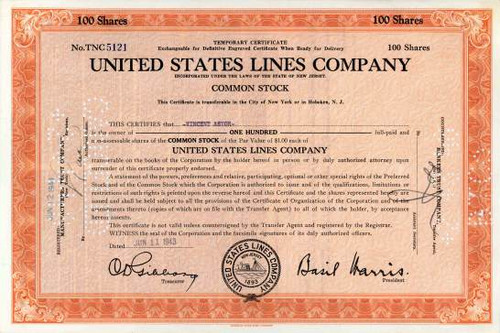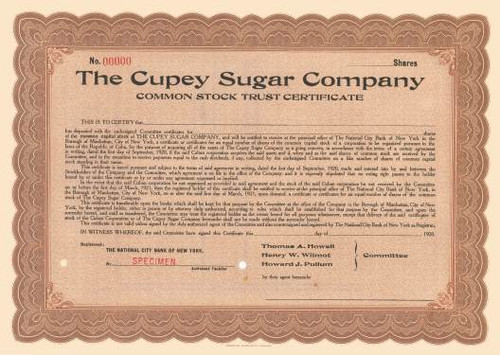Beautifully engraved certificate from Vertientes - Camaguey Sugar Company of Cuba issued in 1947. This historic document was printed by the American Banknote Company and has an ornate border around it with a vignette of three allegorical figures. This item has the printed signatures of the company's officers and is over 60 years old. This is a famous sugar company that was nationalized when Castro took over in Cuba. 
Certificate Vignette The certificate was issued to (but not signed by) Vincent Astor (1891-1959), son of the John Jacob Astor who built the well-known hotels, departed markedly from Astor family conservatism. (William) Vincent Astor was born on Nov. 15, 1891, in New York City. After attending Harvard, he served in the United States Navy in both world wars. Under his direction the family real estate holdings underwent significant change. Major portions of Astor property in the heart of New York City were sold, including the site for the Empire State Building. William Vincent Astor died in New York City on Feb. 3, 1959. He sold some Astor-owned properties to New York City under generous terms so that they might be converted into housing projects. In addition, he backed the New Deal, though temporarily, and supported other social reforms. He took an active role in managing the family real estate holdings, and during the last two decades of his life headed the corporation that published Newsweek magazine. He willed most of his fortune to the Vincent Astor Foundation. Vincent Astor was a directory of the Cuban-Dominican Sugar Company as well as many other companies. History of Sugar in Cuba - Sugar cane, originating in Asia, was brought to southern Spain by the Arabs, hence it passed to the Canary Islands, of Cape Verde and Madeira, where it was being cultivated at the time of the conquest of America. In his second voyage to the Antilles, Christopher Columbus took it to La Hispaniola (Santo Domingo) where it was first planted in 1493. The first sugar factory or mill was established in that island in 1516. In Cuba, sugar cane was introduced during the rule of its first Governor, Diego Velazquez (1511-1524). From that time on, it was cultivated in the island, but no sugar mill was established until the last lustrum of the XVI century. At that time the Cuban sugar industry was based on the granting of certain privileges1 monetary aid from the Crown, and the authorization to import slaves. During the XVII century and the greater part of the XVIII the industry developed very slowly, so much so that in 1760 it was employing the same number of slaves as a century and a half before in 1595. The capture of Havana by the English (1762) gave some impetus to the sugar industry through the introduction of thousands of slaves at less cost than until then and the cheapening of the utensils and materials used in the mills due to free importation thereof. Later, the opening of Spanish ports to foreign sugars stimulated the development of the sugar industry from 1783. Sugar production grew without interruption up to 1779, and Cuba supplied Spain with practically all the sugar necessary for the latter's consumption, some 125,000 quintals or hundredweights per year (50,000 bags of 250 lb.). Towards the close of the XVIII century, a series of historical events gave Cuban sugar a strong push. Chief among them was the revolution and independence of Haiti in 1804. The ruin of the sugar industry of that country, at the time the. world's greatest producer, opened a new era for Cuba's sugar industry. Beginning in 1818, when Spain decreed freedom for foreign trade, Cuba took its place as the world's greatest sugar producer. During the XIX century Cuba's sugar industry developed intensely, based on the introduction of the steam engine, whose use became general in the third decade of the century; on the building of railways starting in 1837; on the advances in the manufacture of sugar and the cultivation of sugar cane; on the free importation of slaves, first in 1799; and on the substitution of slave labor for paid labor (1880-1885); on the competition of beet sugar; and on the transformation of the mills into "centrals", with ample supply of capital, abundant applications of technical know-how, and the division between industrial and agricultural labor, with the establishment of the "Colono" or cane grower. During that century, in spite of the Ten Years War of Independence, sugar production grew notably in Cuba, increasing almost five-fold from 1850 (223,145 Spanish long tons) up to 1894 (1.054,214 tons). The Second War of Independence (1895-1898) saw a great recession in sugar production which in 1897 was a mere 212,051 tons, less than that during the middle of the century. Independence facilitated the reorganization of the sugar industry on more advantageous bases than those of the XIX century. The doors of the United States market were opened; materials used by the industry were cheaper; communications, both by rail and road, were greatly increased; yellow fever was eliminated thanks to the great discovery of Cuban scientist, Dr. Carlos J. Finlay; access was given to strong current of European immigration; and the investment of foreign capital in the sugar industry, particularly U.S. capital, was huge; so much so that from an estimated 50 million dollars in 1895 they increased to 700 million dollars in 1929. All these favorable factors brought about a rapid development of the Cuban sugar industry during the first quarter of the century. In 1913 production for the first time passed the figure of 2 million Spanish long tons; in 1910 it passed 3 million tons; in 1919 that of 4 million tons, and in 1925 it soared to 5 millions tons, thus quintuplicating in five lustrums the maximum production obtained during the previous century. Beginning in 1926, sugar entered into a crisis of over-production in the whole world and Cuba started restricting its sugar crops. The crisis, and the high tariff of two cents per pound for sugar in the United States (1930) brought about a vertical decline in the island's sugar production. In 1933 production reached only 1,994,238 Spanish long tons. Cuba did not produce a 5 million ton crop until 1947, and in 1952 a production of 7,011,637 tons was recorded. On 26 July 1953 over 100 militants and students led by a young lawyer, Fidel Castro, attacked the Moncada army barracks in Santiago de Cuba. The assault was thwarted and most of the rebels killed. Castro was sentenced to 15 years in prison. Two years later he was granted amnesty under popular pressure and fled to Mexico City where he gathered other revolutionaries around him, including his brother Raúl and a radical Argentine doctor named Ernesto Guevara. In December 1956 Castro and 81 cohorts sailed from Mexico in a small yacht called Granma: the Cuban Revolution had begun. The guerrillas established themselves in the Sierra Maestra mountains near Santiago and slowly gained support among the peasants. In the cities an underground resistance grew, staging protests and supplying new recruits and arms to Castro's fighters. In May 1958 Batista dispatched 10,000 soldiers to wipe out the guerrillas but the campaign failed. Castro's troops fought back led by 'Che' Guevara and Camilo Cienfuegos. As popular support for the guerrillas spread Batista's troops became demoralized. Finally, his army collapsed and the dictator fled to the Dominican Republic on New Year's Day, 1959, with $40 million. Che and Camilo arrived in Havana the next day. Castro drove from Santiago to Havana, arriving on 8 January. He named himself, Prime Minister on 25 January. The new government immediately nationalized all land holdings over 400 hectares. Cuba also nationalize all US-owned companies and by establishing closer economic and political ties with the Soviet Union. Among the companies that were nationalized, was Compania Azucarera Vertientes-Camaguey de Cuba (C.A.V.), a Cuban corporation whose stock was mostly owned by U.S. residents. Washington began an economic blockade and cut off diplomatic relations in January, 1961. The US effort to topple the revolutionary government culminated in the 17 April 1961 Bay of Pigs invasion by 1,400 CIA-trained Cuban exiles. The invasion failed miserably. The following October the Cuban Missile Crisis brought the world to the brink of nuclear war. Moscow had installed 40 nuclear missiles on Cuban soil. The US threatened war unless the missiles were removed: in the end the Soviets backed down in exchange for a promise from President Kennedy not to invade.

Certificate Vignette










